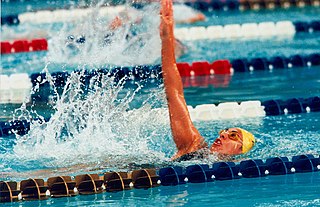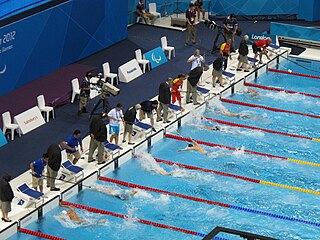The world records in disability swimming are ratified by the International Paralympic Committee (IPC). These are the fastest performances in swimming events at meets sanctioned by the IPC.
Races are held in four swimming strokes: freestyle, backstroke, breaststroke and butterfly over varying distances and in either individual or relay race events. Medley events combine all four strokes, again either as an individual format (swum in order: butterfly, backstroke, breaststroke, freestyle) and as a team relay (swim in order: backstroke, breaststroke, butterfly, freestyle). Competitors are allocated a classification based on their ability in the water, with records available for each event in each classification. [1]
This currently used classification system has been in use since the 2000 Summer Paralympics.
Records are recorded in men's and women's competition in both long course (50 m) and short course (25 m) swimming pools. On each list there are almost 200 records, so they are therefore presented in separate articles:

Matthew John Cowdrey is an Australian politician and Paralympic swimmer. He presently holds numerous world records. He has a congenital amputation of his left arm; it stops just below the elbow. Cowdrey competed at the 2004 Paralympic Games, 2006 Commonwealth Games, 2008 Paralympic Games, 2010 Commonwealth Games, and the 2012 Paralympic Games. After the 2012 London Games, he is the most successful Australian Paralympian, having won thirteen Paralympic gold medals and twenty three Paralympic medals in total. On 10 February 2015, Cowdrey announced his retirement from swimming.

Jessica Tatiana Long is a Russian-American Paralympic swimmer from Baltimore, Maryland, who competes in the S8, SB7 and SM8 category events. She has held many world records and competed at five Paralympic Games, winning 29 medals. She has also won over 50 world championship medals.

S8, SB7, SM8 are disability swimming classifications used for categorizing swimmers based on their level of disability. This class includes a number of different disabilities including people with amputations and cerebral palsy. The classification is governed by the International Paralympic Committee, and competes at the Paralympic Games.
S8, SB8, SM8 are disability swimming classifications used for categorizing swimmers based on their level of disability. Swimmers in this class generally have severe weakness in one leg. This class includes a number of different disabilities including people with amputations and cerebral palsy. The classification is governed by the International Paralympic Committee, and competes at the Paralympic Games.

S7, SB6, SM7 are disability swimming classifications used for categorizing swimmers based on their level of disability. Swimmers in this class have use of their arms and trunk. They have limited leg function or are missing a leg or parts of both legs. This class includes a number of different disabilities including people with amputations and cerebral palsy. The classification is governed by the International Paralympic Committee, and competes at the Paralympic Games.
S6, SB5, SM6 are disability swimming classifications used for categorising swimmers based on their level of disability. This class includes people with a number of different types of disability including short stature, major limb impairment or loss in two limbs. This includes people with cerebral palsy, people with dwarfism and amputees. The class competes at the Paralympic Games.
S5, SB4, SM5 are disability swimming classifications used for categorizing swimmers based on their level of disability. The class includes people with a moderate level of disability, and includes people with full use of their arms and hands, but limited to no use of their trunk and legs. It also includes people with coordination problems. A variety of disabilities are represented by this class including people with cerebral palsy. The class competes at the Paralympic Games.
S4, SB3, SM4 are disability swimming classifications used for categorising swimmers based on their level of disability. Swimmers in this class have coordination problems affecting all four of their limbs, or have movement in their arms but no trunk or leg function. They also generally have weakness in their hands and arms. A variety of disabilities are represented by this class including people with quadriplegia from spinal cord injury or similar. Events this class can participate in include 50m and 100m Freestyle, 200m Freestyle, 50m Backstroke, 50m Butterfly, 50m Breaststroke, and 150m Individual Medley events. The class competes at the Paralympic Games.
S3, SB2, SM3 are disability swimming classifications used for categorising swimmers based on their level of disability. People in this class have decent arm and hand function, but no use of their trunk and legs. They have severe disabilities in all their limbs. Swimmers in this class have a variety of different disabilities including quadriplegia from spinal cord injury, severe cerebral palsy and multiple amputations.
S2, SB1, SM2 are disability swimming classifications used for categorizing swimmers based on their level of disability. People in this class have limited use of their arms, and no or extremely limited use of their hands, legs and trunk. Swimmers in this class have a variety of different disabilities including cerebral palsy and amputations.
S1, SB1, SM1 are disability swimming classifications used for categorising swimmers based on their level of disability. The classifications cover athletes with "very severe coordination problems in four limbs or have no use of their legs, trunk, hands and minimal use of their shoulders only". Swimmers in this class have a variety of different disabilities including cerebral palsy.
S13, SB13, SM13 are disability swimming classifications used for categorising swimmers based on their level of disability. Jane Buckley, writing for the Sporting Wheelies, describes the swimmers in this classification as having: "Swimmers who are the most sighted but are considered to be blind according to the IBSA B3."

S12, SB12, SM12 are disability swimming classifications used for categorising swimmers based on their level of disability.

S11, SB11, SM11 are disability swimming classifications for blind swimmers.

The 2013 IPC Swimming World Championships was the seventh IPC Swimming World Championships, an international swimming competition, the biggest meet for athletes with a disability since the 2012 Summer Paralympics. It was held in Montreal, Quebec, Canada and lasted from 12 to 18 August. Around 530 athletes competed from 57 different countries. The event was held in the Parc Jean Drapeau Aquatic Complex located at the Parc Jean-Drapeau in Montreal. 172 events were contested with 43 new world records set.

The 2014 IPC Swimming European Championships was an international swimming competition held in Eindhoven, the Netherlands, from the 4th to the 10th of August. Around 375 athletes from 35 different countries attended. The venue, the Pieter van den Hoogenband Swimming Stadium, also held the 2010 IPC Swimming World Championships.
The 2010 IPC Swimming World Championships was the sixth edition of the IPC Swimming World Championships, an international swimming competition, the biggest meet for athletes with a disability since the 2008 Summer Paralympics. It was held in Eindhoven, Netherlands and lasted from 14 to 21 August.

The 2015 IPC Swimming World Championships was the eighth IPC Swimming World Championships, an international swimming competition for athletes with a disability. It was held in Glasgow, United Kingdom and took place from 13 to 19 July. Around 580 athletes from around 70 countries competed at the games, with Russia topping the tables with most gold medals and medals won. The event was held at the Tollcross International Swimming Centre located within Tollcross Park in Glasgow. Initially awarded as the IPC Swimming European Championships, the event was upgraded to a World Championship after a change to the IPC calendar.
The 2016 IPC Swimming European Championships was an international swimming competition. It was held in Funchal, Madeira running from 30 April to 7 May. Around 450 athletes from 50 different countries attended the competition. This was the last major swimming tournament for disabled athletes prior to the 2016 Summer Paralympics in Rio, and acted as a qualifying event for the Rio Games. To increase the possibility of qualification for top swimmers, the championships was made an Open tournament allowing competitors from countries outside Europe to compete.